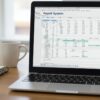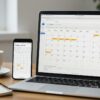Managing a team without clear insights into their performance can feel like driving blindfolded. How do you know who’s excelling, who needs support, or where your business stands? This is where an employee performance dashboard comes in. It’s a powerful tool that helps businesses track, analyze, and improve their team’s productivity and efficiency.
In this blog, we’ll break down everything you need to know about employee performance dashboards—what they are, why they matter, and how they can transform your business. Whether you’re in human resources, running a business, or managing a store, this guide will help you understand how to use this tool effectively.
What is an Employee Performance Dashboard?
An employee performance dashboard is a visual tool that displays key metrics about your team’s performance. Think of it as a monitoring system that gives you a clear picture of how your employees are doing. It pulls data from various sources, like tracking systems or evaluation tools, and presents it in an easy-to-understand format, such as charts, graphs, or tables.
For example, if you’re managing a company, the dashboard can show you which employees are meeting their targets, who’s falling behind, and where improvements are needed. It’s not just about numbers—it’s about understanding your workforce and making informed decisions to boost productivity and management.
Key Features of an Employee Performance Dashboard
Not all dashboards are created equal. A good employee performance dashboard comes with features that make it easy to use and highly effective. Here are some key features to look for:
- Real-Time Tracking:
- See live updates on employee performance. This helps you stay on top of things and address issues as they arise.
- Customizable Metrics:
- Every business is different, so your dashboard should allow you to choose the metrics that matter most. For example, a store might focus on sales targets, while a company might prioritize project completion rates.
- Visual Reports:
- Dashboards use charts, graphs, and tables to present data in a way that’s easy to understand. No need to sift through spreadsheets!
- Employee Feedback Integration:
- Combine performance data with employee reviews or appraisals to get a complete picture of their performance.
- Key Metrics at a Glance:
- A good dashboard highlights the most important metrics, like productivity, attendance, and quality of work, so you can make quick decisions.
Why Do You Need an Employee Performance Dashboard?
If you’re still wondering whether an employee performance dashboard is worth it, here are some reasons why it’s a game-changer:
- Improves Decision-Making:
- With clear data at your fingertips, you can make informed decisions about promotions, training, or resource allocation.
- Boosts Productivity:
- When employees know their performance is being tracked, they’re more likely to stay focused and meet their goals.
- Identifies Training Needs:
- The dashboard can highlight areas where employees need improvement, helping you plan targeted training programs.
- Enhances Team Collaboration:
- By sharing performance insights with your team, you can foster a culture of transparency and collaboration.
For example, a human resources team can use the dashboard to identify top performers and reward them, while a store manager can track sales performance and adjust strategies accordingly.
Tracking employee performance is just one part of effective workforce management. Another crucial aspect is ensuring accurate payroll processing. If you want to streamline payroll management and reduce errors, check out our guide on How to Create a Payroll in Excel: A Step-by-Step Guide. It will help you simplify salary calculations and ensure your employees are paid accurately and on time.
Key Metrics to Track on an Employee Performance Dashboard
What makes an employee performance dashboard truly effective is the metrics it tracks. Here are some of the most important ones:
- Productivity:
- Measure how much work employees are completing. For example, a call center might track the number of calls handled per agent.
- Attendance:
- Track punctuality and absenteeism to ensure your team is present and engaged.
- Quality of Work:
- Evaluate the accuracy and efficiency of tasks. This is especially important in roles where precision matters.
- Employee Satisfaction:
- Use surveys or feedback tools to gauge morale and identify areas for improvement.
- Performance Reviews:
- Combine quantitative data with qualitative insights from employee appraisals to get a holistic view of performance.
For instance, a business might use these metrics to identify top performers and reward them, while a store might use them to optimize staffing during peak hours.
How to Use an Employee Performance Dashboard Effectively
Having an employee performance dashboard is one thing, but using it effectively is another. Here are some tips to get the most out of your dashboard:
- Set Clear Goals:
- Define what success looks like for your team. For example, a company might aim to increase sales by 10% in the next quarter.
- Regularly Review Data:
- Check the dashboard weekly or monthly to stay updated on performance trends.
- Share Insights with Your Team:
- Use the data to provide constructive feedback and celebrate achievements.
- Adjust Strategies:
- Identify areas for improvement and take action. For example, if the dashboard shows low productivity, consider offering additional training.
Think of the dashboard as your team’s report card—it’s not just about grading but also about helping them improve.
Conclusion
An employee performance dashboard is more than just a tool—it’s a roadmap to success. By tracking key metrics, identifying trends, and making data-driven decisions, you can transform the way your business operates. Whether you’re in human resources, managing a store, or running a company, this tool can help you unlock your team’s full potential.
Ready to take your team’s productivity to the next level? Explore our employee performance dashboard today and see the difference it can make!
FAQs
What types of metrics can I track on an employee performance dashboard?
You can track a variety of metrics, including:
- Productivity: How much work employees are completing.
- Attendance: Punctuality and absenteeism.
- Quality of Work: Accuracy and efficiency of tasks.
- Employee Satisfaction: Feedback and morale levels.
- Performance Reviews: Insights from evaluations and appraisals.
These metrics help you understand your workforce and make informed decisions.
How does an employee performance dashboard benefit my business?
An employee performance dashboard benefits your business by:
- Improving decision-making through real-time data.
- Boosting productivity by keeping employees accountable.
- Identifying training needs and skill gaps.
- Enhancing team collaboration and transparency.
- Providing a sample framework for measuring success.
Can I customize an employee performance dashboard for my specific needs?
Yes, most employee performance dashboards are customizable. You can choose the types of metrics and data that matter most to your business. For example, a store might focus on sales targets, while a company might prioritize project completion rates. Customization ensures the dashboard meets your unique needs.
How do I ensure my team uses the dashboard effectively?
To ensure effective use of the employee performance dashboard:
- Set clear goals and expectations.
- Train your team on how to interpret the data.
- Regularly review and discuss performance insights.
- Use the dashboard as a tool for constructive feedback and improvement, not just monitoring.


